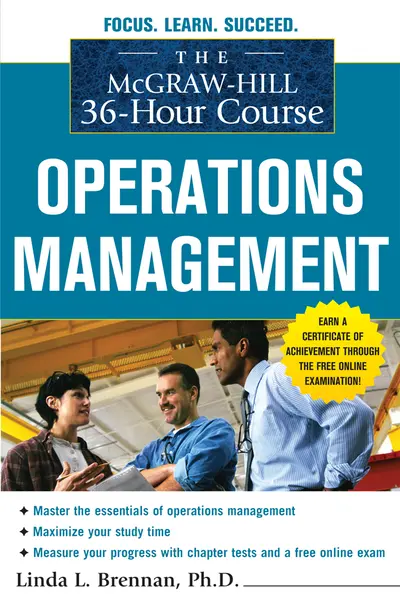My Account Details

ISBN10: 0071743839 | ISBN13: 9780071743839

Step 1 . Download Adobe Digital Editions to your PC or Mac desktop/laptop.
Step 2. Register and authorize your Adobe ID (optional). To access your eBook on multiple devices, first create an Adobe ID at account.adobe.com. Then, open Adobe Digital Editions, go to the Help menu, and select "Authorize Computer" to link your Adobe ID.
Step 3. Open Your eBook. Use Adobe Digital Editions to open the file. If the eBook doesn’t open, contact customer service for assistance.
Take a crash course in boosting operational efficiency!
Whether a business manufactures trucks, delivers packages, or sells coffee, it lives and breathes on its operations. Without exception. Ensuring smooth, efficient processes is a challenging task--but the rewards are immense.The McGraw-Hill 36-Hour Course: Operations Management puts you on the fast track to bolstering and managing the effectiveness of your organization’s operations. Complete with exercises, self-tests, and an online final exam, this virtual immersion course in operations management teaches you how to:- Evaluate and measure existing systems’ performance
- Use quality management tools like Six Sigma and Lean Production
- Design new, improved processes
- Define, plan, and control costs of projects
Chapter 1
Results over Routine
(Motivation for this Study; Operations as Competitive Advantage, Guiding Principles for Operations, Technique: Identifying Sources of Competitive Advantage)
Chapter 2
Practical Approach
(Systems Thinking,Business Research Framework, Technique: Evaluating Transformation Systems)
Chapter 3
Desired Results
(Bottom-Line Impact, Measurement Theory, Technique: Developing a Balanced Measurement System)
PART II. RESULTS AT THE ORGANIZATIONAL LEVEL
Chapter 4
Organizational Performance
(The Organization as a Value Chain, Product and Service Design, Operational Decision Points, Technique: Using a House of Quality)
Chapter 5
Quality Practices and Continuous Improvement
(Definitions and Origins of Quality Management, Principles and Practices for Quality,Six Sigma Approach, Technique: Performing Problem Determination, Managing for Results,A Practical Approach to Operations Management)
Chapter 6
Technology across the Value Chain
(Product, Process and Information Technologies,Organizational Learning and Knowledge Management,Technique: Applying Maturity Models)
PART III. RESULTS AT THE PROCESS LEVEL
Chapter 7
Process Design
(Defining Processes, Theory of Constraints, Levers for Capacity Management, Technique: Creating Forecasts)
Chapter 8
Process Analysis & Reengineering
(Costs of Quality, Sources of Waste, Reengineering Principles & Pitfalls, Techniques: Developing Flow Charts)
Chapter 9
Process Control
(To Change or Not to Change: Common vs. Assignable Causes,Statistical Process Control and the Beauty of the Normal Distribution, Attributes versus Variables, Chart Mechanics, Process Capability, Implementation Considerations, Technique: Creating and Interpreting Control Charts)
PART IV. ACHIEVING RESULTS
Chapter 10
Project Definition
(Project Success Factors and Career-Ending Moves, Managing Change, Project Initiation, Project Planning, Technique: Developing a Statement of Work)
Chapter 11
Project Control
(Schedule Development, Feasibility Analysis, Communications Management, Project Closings, Technique: Using the Critical Path Method)
Chapter 12
Project Management
(Project Roles and Responsibilities, Ethical and Effective Leadership, Groups versus Teams; Technique: Running Effective Meetings)
Need support? We're here to help - Get real-world support and resources every step of the way.